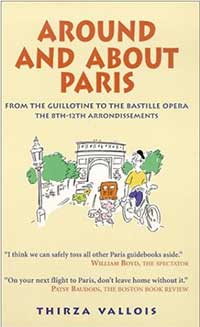
November in Paris begins with yet another long weekend away from work – le pont de la Toussaint (All Saints Day) – one of many strewn along the French calendar year. As Paris florists bring out their stock of chrysanthemum for the annual commemoration of Parisians now gone, and as other Parisians pack their cars and pile up at the exits of the city for yet another frantic weekend on France’s chock-a-block highways, why not use this most appropriate time of year for a less stressful outing to one of the capital’s cemeteries. This should be completed with the purchase of Georges Brassens’ “La Ballade des Cimetières,” a perfect way to record your outing and do your French homework. Continue reading “Paris Cemeteries, the Saints Go Marching”



 It was on the southern edge of the arrondissement, in the wretched Faubourg St-Antoine that rumbling discontent was first channeled into working-class consciousness and into organized action against exploitation. When word was spread on April 28, 1789 that Monsieur Réveillon, a painted-paper manufacturer on rue de Montreuil, was planning to reduce his workers’ wages, the Faubourg St-Antoine rose up in a violent insurrection. Monsieur Réveillon had not anticipated such a reaction, for the lowering of wages he had intended was proportionate to the drop in the price of bread fixed by the authorities to ease social tension. His 400 workers had a different idea of fairness and Réveillon, terrified, ran for his life and sought shelter in the neighboring Bastille, the ominous fortress looming west of the faubourg. It took the intervention of troops and a death toll of 30 to put down the revolt, but any wise ruler should have sensed that further trouble was brewing …
It was on the southern edge of the arrondissement, in the wretched Faubourg St-Antoine that rumbling discontent was first channeled into working-class consciousness and into organized action against exploitation. When word was spread on April 28, 1789 that Monsieur Réveillon, a painted-paper manufacturer on rue de Montreuil, was planning to reduce his workers’ wages, the Faubourg St-Antoine rose up in a violent insurrection. Monsieur Réveillon had not anticipated such a reaction, for the lowering of wages he had intended was proportionate to the drop in the price of bread fixed by the authorities to ease social tension. His 400 workers had a different idea of fairness and Réveillon, terrified, ran for his life and sought shelter in the neighboring Bastille, the ominous fortress looming west of the faubourg. It took the intervention of troops and a death toll of 30 to put down the revolt, but any wise ruler should have sensed that further trouble was brewing … 
 Of all the 8 new arrondissements incorporated into Paris in January 1860 (13th to 20th), the 17th is Baron Haussmann’s creation par excellence; for, despite the ‘deep chasm’ that seprated north from west, no arrodissement was as true to the new middle-class spirit of the Second Empire (and later the Third Republic) or promoted the values it stood for to the same degree.
Of all the 8 new arrondissements incorporated into Paris in January 1860 (13th to 20th), the 17th is Baron Haussmann’s creation par excellence; for, despite the ‘deep chasm’ that seprated north from west, no arrodissement was as true to the new middle-class spirit of the Second Empire (and later the Third Republic) or promoted the values it stood for to the same degree. 
 A tiny patch of Africa transplanted to Paris, the Goutte-d’Or is one of the last remnants of genuine working-class village life in Paris. Despite desperate struggles by local associations to rescue it from the hands of technocrats determined to “clean up” the area, demolition has already begun and the usual characterless buildings of our times are cropping up, notably the new police station, easily distinguishable by its tricolored flag.
A tiny patch of Africa transplanted to Paris, the Goutte-d’Or is one of the last remnants of genuine working-class village life in Paris. Despite desperate struggles by local associations to rescue it from the hands of technocrats determined to “clean up” the area, demolition has already begun and the usual characterless buildings of our times are cropping up, notably the new police station, easily distinguishable by its tricolored flag. 

